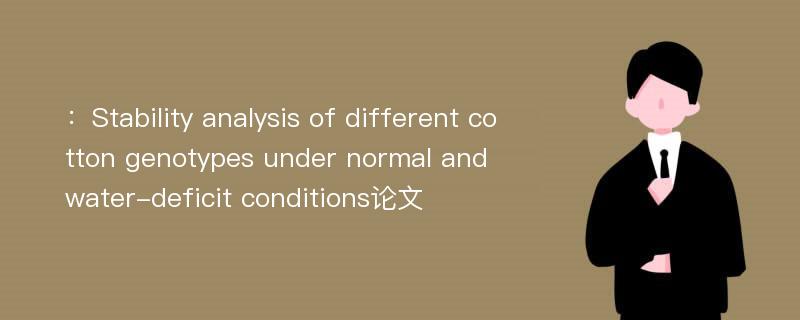
本文主要研究内容
作者(2019)在《Stability analysis of different cotton genotypes under normal and water-deficit conditions》一文中研究指出:Cotton plant observes significant reduction in seed cotton yield when subjected to water stress. To find out genotypes having better drought tolerance, seven genotypes of Gossypium hirsutum L. were tested under two moisture levels, i.e., normal and water deficit stress conditions at five locations of Punjab, Pakistan(Faisalabad, Sahiwal, Vehari, Rahim Yar Khan, and Bahawalpur) in 2013 and 2014. Genotype×environment interaction(GEI) was studied using the genotype main effects and genotype by environment interaction(GGE) biplot and additive main effect and multiplicative interaction analysis. The genotypes G3(7001/11) and G6(FH-942) were stable under normal condition, while under drought condition, the stable genotype was G5(FH-326) when analysed using additive main effects and multiplicative interaction(AMMI) biplot scheme. While GGE biplot analysis on the basis of best performance revealed that under normal condition the genotypes, G1(L-13/10) and G2(FH-2056/10), carrying the common position in biplot. Whereas, under water deficit stress condition, G5 was the best adaptive genotype at all five locations. In the same way, ranking of genotypes showed that the G5 was the ideal genotype under both conditions. So, it is concluded that the genotype G5(FH-326) was found best for water deficit stress condition and can be cultivated under water scarce areas of Punjab.
Abstract
Cotton plant observes significant reduction in seed cotton yield when subjected to water stress. To find out genotypes having better drought tolerance, seven genotypes of Gossypium hirsutum L. were tested under two moisture levels, i.e., normal and water deficit stress conditions at five locations of Punjab, Pakistan(Faisalabad, Sahiwal, Vehari, Rahim Yar Khan, and Bahawalpur) in 2013 and 2014. Genotype×environment interaction(GEI) was studied using the genotype main effects and genotype by environment interaction(GGE) biplot and additive main effect and multiplicative interaction analysis. The genotypes G3(7001/11) and G6(FH-942) were stable under normal condition, while under drought condition, the stable genotype was G5(FH-326) when analysed using additive main effects and multiplicative interaction(AMMI) biplot scheme. While GGE biplot analysis on the basis of best performance revealed that under normal condition the genotypes, G1(L-13/10) and G2(FH-2056/10), carrying the common position in biplot. Whereas, under water deficit stress condition, G5 was the best adaptive genotype at all five locations. In the same way, ranking of genotypes showed that the G5 was the ideal genotype under both conditions. So, it is concluded that the genotype G5(FH-326) was found best for water deficit stress condition and can be cultivated under water scarce areas of Punjab.
论文参考文献
论文详细介绍
论文作者分别是来自Journal of Integrative Agriculture的,发表于刊物Journal of Integrative Agriculture2019年06期论文,是一篇关于,Journal of Integrative Agriculture2019年06期论文的文章。本文可供学术参考使用,各位学者可以免费参考阅读下载,文章观点不代表本站观点,资料来自Journal of Integrative Agriculture2019年06期论文网站,若本站收录的文献无意侵犯了您的著作版权,请联系我们删除。
